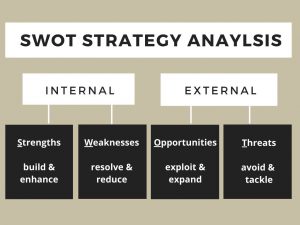At some point in the history of your business, you’ve probably conducted some sort of market research so you could gain a better understanding of your target audience. But have you ever taken a good, hard look at how your business is running so you can better understand what’s going well and what needs work? If not, you should consider doing what’s known as a SWOT analysis, or an analysis of your strengths, weaknesses, opportunities, and threats. Asking honest questions about your business can help you to pinpoint inefficiencies and highlight your strengths, so you can improve productivity and increase sales.
The Why and How of SWOT
Why conduct a SWOT analysis? Well, doing so will give you a better understanding of the internal workings of your organization, as well as a better understanding of how you compare to your competition. It can be easy to get bogged down in all the little day-to-day issues at your business, meaning you could be missing out on the broader view of what’s going on in your organization, or the bigger picture of how it occupies space in your industry – and a SWOT analysis will give you a bird’s eye view, so to speak, of all of this.
And the great thing about a SWOT analysis is that it focuses on your business in a real-world context, so you’ll end up with actionable steps you can take to make improvements, or capitalize on your strengths. So where do you start? Before we get down to the specifics of examining your strengths, weakness, opportunities, and threats, let’s take a quick look at how generally to put a SWOT analysis together:
- Get a team together – If you’re a bigger business, with multiple employees in different departments (or even if you have any size team), gather representatives from every department and team to get a variety of perspectives. If you’re flying solo in your business, you can still try and get perspectives other than your own by being creative: try involving your customers, friends and family who know your business, vendors you use, or even people you outsource tasks to, like your accountant.
- Get your ideas out there – Once you’ve got a team together, take a little time to brainstorm, perhaps by having everyone write down ideas on sticky notes and then sticking them all up on a board when they’re done, grouping similar ideas together.
- Get your ideas together – Prioritize the ideas that come out of this session, whether you allow everyone to vote or you simply choose what you think is most actionable.
Once you’ve done all this, you can create your SWOT analysis, which will look like a square divided into four quadrants, headed “strengths,” “weaknesses,” “opportunities,” and “threats,” with the finalized ideas in the appropriate category.
The Categories and Questions
If you’re wondering where to even begin brainstorming for your SWOT analysis, the best way to get going is by asking questions related to each category, so you can focus on how your business is performing in or reacting to them.
We say “performing in” or “reacting to” because the four categories are actually broken down into two subcategories: internal and external factors. Your strengths and weaknesses are considered internal factors, because they are things having to do with the performance of your business, or things that you can control, like who’s on your team, your location, or your intellectual property. Your opportunities and threats are external factors, or things that you can’t control and that you must find a way to react to, like competitors, vendor pricing, or trends in consumer behavior.
So what does each category look like, and what should you be asking?
Strengths
Strengths are the internal, positive attributes of your company and, again, are things within your control. To determine what you and your analysis team think are the things you’re performing best at, ask questions like:
- What do your customers love about your products or services?
- What makes your business unique?
- What assets do you have, either in manpower (knowledge, skills, education, reputation) or physical (cash, customers, technology, equipment)?
- What competitive edge do you have, or what do you do better than other businesses?
- What has been your business’ greatest achievement?
Weaknesses
Another internal set of attributes, your weaknesses are things you need to improve upon to become more competitive. To figure these out, try asking things like:
- What have you received negative feedback or reviews about?
- Do you have customers who are canceling on you, and why?
- Are there assets that you are lacking, like money or equipment?
- In what area do you or your employees need more knowledge or training?
- Are there areas in which your business is not competitive?
Opportunities
Now we get to the external factors in your SWOT analysis – these might be a little bit harder to figure out because they are the ones that are beyond your control, and it might require a little more effort and reliance on data to determine. But, you can start by asking yourself questions about your opportunities like:
- Is your market growing and are there trends that might mean more people will want your product or service?
- In what ways can you take advantage of any changes affecting your industry?
- What new business ventures can you afford to take on in the next 6 months?
- Are there gaps in the market that you might be able to fill?
Threats

There are always going to be external threats that your business faces, but doing a SWOT analysis can help you be proactive in tackling them. Ask questions like:
- Are there competitors entering your market?
- Will suppliers be able to offer you the same materials for the same prices for the foreseeable future?
- How might changes in technology affect your business?
- Is consumer behavior changing in a way that could affect your business?
- Are market trends changing?
How to Use Your SWOT Analysis
Ok, so by now you’ve gathered a whole lot of facts about your business – but creating a SWOT analysis is not merely a fact-finding mission. You have to take what you’ve learned and convert it into a real strategy, with actionable steps and goals with a specific timeline.
To do this, look at each quadrant of your SWOT analysis; start with the strengths quadrant and compare it with your opportunities and threats quadrants. Decide how you can use your strengths to take advantage of the opportunities and help combat the threats, and then make a list of actions you can take – write them down on a timeline, giving yourself goals or milestones to meet each quarter, month, etc. 
Next, it’s time to move to the weaknesses quadrant – hopefully you’ve been very honest about them! You’ll need to think about ways to convert your weaknesses into strengths by focusing on what you can do better, and by analyzing what external opportunities could possibly combat your weaknesses. In addition, think about how working on your weaknesses could possibly help ward off any external threats that might be coming your way, and, again, create an action list that you can prioritize and schedule.
Once you’ve done your SWOT analysis, you’ll find not only that you have a more comprehensive understanding of your business and its place in the market, but you’ll have gone a long way toward creating a strategic, actionable plan for your business. All of that can add up to achievable growth goals and a big boost in sales – so gather your team together and get analyzing!
